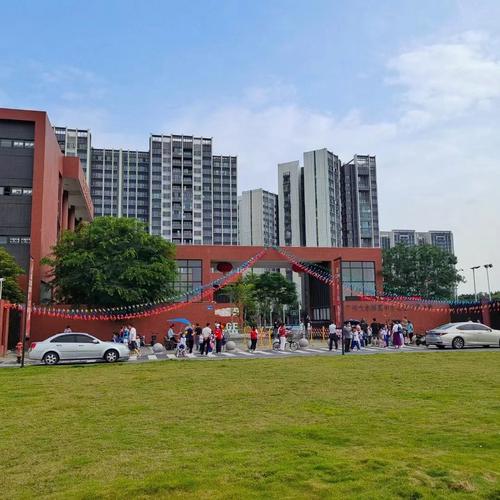广州市花都广附教育集团联合广东外语外贸大学附属花都学校2025年公开招聘54名劳动合同制教师公告
广州市花都广附教育集团是经广州市花都区教育局批准成立的立体式教育集团。集团以广大附中花都学校为核心校,成员校有广州大学附属中学花都附属小学、花都区新雅街镜湖学校、花都区新华街第六小学、花都区花山镇花山初级中学。集团明确提出“重视人才选拔培养、集团各分校打造特色名片、以优势特色引领发展”的统一办学思路,全面传承广州大学附属中学的先进办学理念,致力于将花都广附教育集团打造成花都教育的一张靓丽名片。

广东外语外贸大学附属花都学校---花都区教育局直属公办学校,秉持“坚持全人教育,对学生的终身发展负责,培养走向世界的现代人”的办学宗旨,践行“先做人,后成才”的育人特色。依托广东外语外贸大学教育集团“教育传递价值”的理念、大学资源及集团26所成员校优势,矢志打造区域教育标杆。校园环境优美宜人,配备现代化、标准化的教育教学设施,为孩子的创新与多元发展提供坚实的硬件保障,致力于提升教师的专业技能、教育理念和综合素养。
为进一步加强广州市花都广附教育集团各学校及广东外语外贸大学附属花都学校教师队伍建设,按照公开、平等、竞争、择优的原则,公开招聘劳动合同制教师54名(签订劳动合同,不纳入事业编制,即花都区属新机制教师)。现将有关事项公告如下。

一、招聘职位及人数
具体招聘职位及人数详见《广州市花都广附教育集团、广东外语外贸大学附属花都学校2025年公开招聘劳动合同制教师职位表》(附件1)。
二、招聘对象及条件
(一)招聘对象
1.2025年毕业生,即于2025年1月1日至2025年8月31日期间取得学历、学位证书的毕业生(含持国(境)外学历学位证书人员),毕业时间以毕业证书和学位证书落款时间为准。
2.非2025年毕业生,即于2024年12月31日前取得学历、学位证书的非在读人员(含持国(境)外学历学位证书人员),毕业时间以毕业证书和学位证书落款时间为准。
3.“不限”是指以上两类人员均可。
符合《广东省人力资源和社会保障厅关于印发粤港澳大湾区(内地)事业单位公开招聘港澳居民管理办法的通知》(粤人社规〔2021〕34号)和本公告规定的相关条件的港澳居民,可报考相关职位。
(二)基本条件
1.具有中华人民共和国国籍。
2.遵守中华人民共和国宪法和法律,拥护中国共产党领导和社会主义制度。
3.具有良好的政治素质和道德品行。
4.身体健康,具有适应职位要求的身体条件。
5.具有招聘职位所需的专业技术条件、任职资格、职业资格及技能要求,以及招聘职位所需要的其他条件。
6.法律、法规规定的其他条件。
(三)具体资格条件
1.各职位具体要求详见附件1。
2.关于报考人员的年龄要求,须满足以下条件:①2025年毕业生:具有本科学历及学士学位的,年龄不超过30周岁;具有硕士研究生学历及学位的,年龄不超过35周岁;具有博士研究生学历及学位的,年龄不超过40周岁。②非2025年毕业生:具有本科学历及学士学位的,年龄不超过35周岁;具有硕士研究生学历及学位的,年龄不超过40周岁;具有博士研究生学历及学位的,年龄不超过45周岁。若应聘者具有与应聘职位相应学科中级职称的,年龄可放宽至不超过40周岁;具有与应聘职位相应学科高级职称的,年龄可放宽至不超过45周岁。
年龄计算截至报名首日。(示例:按报名首日为2025年6月1日计算,博士研究生年龄要求1985年6月1日以后出生)。
3.报考人员所学的专业必须与报考职位要求的专业名称及专业代码要求一致。报考人员所学专业按所获毕业证书上的专业为准,辅修专业等非主修专业以及专业名称后面以括号等形式列出的培养方向不能作为报考专业的依据。
如报考人员所学专业未列入《广东省2025年考试录用公务员专业参考目录》(附件2),但所学专业主要课程与报考职位所要求专业的主要课程基本一致的,则须在资格审查时提供与报考职位要求专业的主要课程基本一致的证明材料(包括加盖公章的课程成绩单;院校出具的专业、课程对比情况说明等),经招聘工作领导小组认定为相近专业的方可视为专业符合报考要求。所学专业为学科教学、课程与教学论、小学教育等专业的,其专业研究方向如与报考的职位条件一致,或所学专业主要课程与报考职位所要求专业的主要课程基本一致的,视为符合要求(资格审查时须提供的材料同上)。以研究生学历报考者,研究生或本科所学专业需任一符合专业要求。
报考人员若已取得中小学二级教师以上专业技术资格证书且专业技术资格证上所任教学科与报考职位学科相一致的,可视为专业一致,如进入资格审查环节需出示相关证明材料。
中小学教师专业技术资格证书须在本次公开招聘报名首日前取得(示例:按报名首日为2025年6月1日计算,资格证取得时间需在2025年6月1日前),取得时间以评审通过时间为准。
4.报考人员须持有与报考职位相对应学段以上和对应学科的教师资格证。持有高学段教师资格证的报考人员可报考低学段的职位,其中报考职位为“中小学(学科)教师”的需持有报考学科初中以上学段教师资格证。暂未取得教师资格证的2025年毕业生须承诺入职后在2026年7月15日前取得相应教师资格证,否则取消聘用资格或调整工作岗位。
5.报考语文教师职位人员的普通话水平测试必须达到二级甲等以上。报考初中英语教师职位的人员要求具有国家英语专业八级合格证书。2025年毕业生如暂未取得普通话水平等级等上述相关证书,可放宽至在2026年7月15日前取得相应的等级证书,否则取消聘用资格或调整工作岗位。
6.2025年毕业生如在2025年8月31日前未获得招聘职位所要求的学历和学位证书,则取消聘用资格。
(四)下列人员不得报考
1.受过刑事处罚的;
2.被开除中国共产党党籍的;
3.被开除公职的;
4.被依法列为失信联合惩戒对象的;
5.因涉嫌违法违纪正在接受审计、纪律审查,或者涉嫌犯罪,司法程序尚未终结的;
6.聘用后即构成回避关系的;
7.与花都区教育系统用人单位尚存在劳动关系的劳动合同制教师(即新机制教师);
8.已报名花都区秀全外国语学校教育集团联合花都区铁英学校、花都区教育局北片教育指导中心2025年公开招聘劳动合同制教师或花都区秀全中学教育集团、花都区花东学校、花都区教育局西片教育指导中心2025年公开招聘劳动合同制教师的;
9.法律法规规定的其他情形。
本条所规定处分期限的计算截至报名截止日。
三、招聘程序
按照网上报名、网上确认、打印准考证、综合素质评估、试讲、笔试、资格审查、体检、考察、公示、聘用等程序进行。
(一)网上报名
本次报名仅限网上报名,不接受现场报名。
1.报名方式
(1)报名时间:2025年6月27日9:00-2025年7月3日18:00前。逾期不接受报名。
(2)报名网址:https://www.sydwzk.cn/gdzlxxzp2025,按网上提示方法进行注册、上传照片、填写个人资料信息并完成网上报名。
2.报名要求
(1)每人只限填报1个具体职位。网上报名实行诚信报考,报名阶段不设人工资格审查,由报名系统自动根据考生填写的信息,对报考人员专业、学历学位等职位条件进行校核。报考人员应认真对照本招聘公告规定的报考条件和招聘职位中的专业、学历学位、招聘对象及其他资格条件等,不符合招聘公告要求的任何条件之一的,均不可报名。报考人员须对报名材料的真实性和完整性负责。凡提供虚假材料的,一经查实,取消报考资格或录用资格,并记录在案。本人条件不符合招聘公告和所报考职位资格条件及要求的,责任自负。
(2)报名与考试时使用的身份证必须完全一致,一经在网上完成报名流程,不得改报。
(3)每个职位的计划招聘人数与报名人数的比例原则上达到1:3及以上方可开考。对于达不到开考比例的,经报招聘工作领导小组同意,可视实际情况开考或相应减少或取消职位。
(二)网上确认
1.网上成功报名的考生需登录报名系统进行考前网上确认。
2.考前网上确认时间为:2025年7月3日9:00—2025年7月4日16:00止。考生未在规定时间内按要求完成网上确认的,视为放弃考试资格。
3.考前网上确认的操作方式:登录报名系统-报考管理-报考记录-确认参加综合素质评估。
4.完成考前网上确认的考生方能参加综合素质评估环节。
(三)打印准考证
完成考前网上确认的考生请于2025年7月6日9:00起自行登录报名网站下载打印准考证,不再另行通知。准考证是参加本次公开招聘各环节的重要证件,请考生妥善保管。
(四)综合素质评估
时间:2025年7月7日—10日(具体时间安排请以准考证为准)。
地点:广州市花都区花城街永成路2号(广大附中花都学校小学部)。
综合素质评估采用无领导小组讨论形式,综合素质评估成绩满分100分,合格成绩为60分,不合格者不能进入下一环节。根据综合素质评估成绩高低排序,各职位按1:5的比例确定进入下一环节人员名单(末位考生同分的,则同分考生一起进入试讲)。未达到上述比例的,按实际人数进入下一环节。本轮成绩仅作为进入下一环节的依据,不计入综合成绩,综合素质评估成绩及是否进入试讲环节预计于2025年7月11日前在报名系统内公布,请考生自行登录查看,如有调整另行通知。
(五)试讲
时间:预计2025年7月11日前(具体安排将在“广大附中花都学校”微信公众号和“广东外语外贸大学附属花都学校”微信公众号发布)。
地点:广州市花都区花城街永成路2号(广大附中花都学校小学部)。
试讲主要考查考生在专业素养、教学组织、语言表达、综合分析等方面的能力。满分100分,合格成绩为60分,按60%折算计入综合成绩,不合格者不能进入笔试环节。
1.语文、数学、英语、化学、道法、地理、生物、特教、心理等采取试讲的方式进行,现场备考时间为20分钟,试讲时间为10分钟,不提供多媒体平台。
2.体育、美术、音乐学科采取先技能展示后试讲的方式进行,考生自行决定是否携带展示所需器材。
①技能展示:
体育:口令加队列队形和个人特长展示,展示时间每人5分钟;
音乐:个人特长展示,考场可提供钢琴,其他器材考生自备。每人5分钟;
美术:集中进行个人特长展示,考生展示一项绘画(国画、水彩、水粉、油画、版画均可)或书法专业技能。作品主题不限,规格自定,创作或照片写生等。考场可提供画架、画板,其他所需材料考生自备。时间为60分钟。
②试讲:内容现场抽取,试讲时间为5分钟,不安排备课。
试讲成绩合格者进入笔试环节。试讲成绩及是否进入笔试环节于2025年7月12日前在报名系统内公布,请考生自行登录查看。
(六)笔试
时间:2025年7月12日前(具体安排将在“广大附中花都学校”微信公众号和“广东外语外贸大学附属花都学校”微信公众号发布)。
地点:广州市花都区花城街永成路2号(广大附中花都学校小学部)。
笔试采取闭卷形式进行,满分100分,合格成绩为60分,按40%计入综合成绩,不合格者不能进入下一环节。笔试内容为教育政策法规、新时代中小学教师职业行为准则、教育学、心理学等方面的基本理论知识。
(七)综合成绩
按照笔试成绩占40%、试讲成绩占60%的比例确定考生综合成绩,按四舍五入保留小数点后2位,合格成绩为60分,低于60分者不得进入下一环节。根据考生综合成绩高低顺序,按招聘职位数1:1的比例确定进入现场资格审查环节人选。如出现综合成绩相同,则按同一职位试讲成绩合格者由高到低排序,高分者进入下一环节;如综合成绩、试讲成绩均相同,则按同一职位笔试成绩合格者由高到低排序,高分者进入下一环节;若综合成绩、试讲成绩、笔试成绩均相同,则再次进行试讲,高分者进入下一环节。
笔试成绩、综合成绩及是否进入下一环节在笔试结束后三个工作日内在报名系统公布,请考生自行登录查看。
(八)现场资格审查
根据考生综合成绩高低顺序,按每个职位1:1的比例确定人选进入现场资格审查。
1.考生需本人凭身份证和准考证以及职位所要求的相关佐证材料(详见附件3)参加资格审查。
2.现场资格审查时间预计为2025年7月13日前,如有调整,另行通知。具体时间、地点,请留意“广大附中花都学校”微信公众号和“广东外语外贸大学附属花都学校”微信公众号通知。
3.资格审查只允许考生本人参加,不得由他人代替。未在规定时间参加资格审查者视为放弃资格审查和后续环节资格。
4.现场告知考生资格审查结果,如出现资格审查不合格的,或未按要求参加资格审查的考生视为放弃资格,不能进入下一环节。
(九)志愿填报
如果一个岗位由两所以上学校进行招聘的,根据综合成绩排名组织考生填报志愿,排名靠前的优先选择。如考生放弃志愿填报,则按综合成绩高低顺序依次递补进入现场资格审查环节。志愿填报时间预计为:2025年7月13日前,如有调整,另行通知,请考生密切留意电话通知。
(十)体检
现场资格审查合格者进入体检环节。体检按照广东省体检相关规定组织实施。对体检结果有疑问的,报考人员可在得到体检结论通知之日起3个工作日内提出复检要求,经批准后在指定医院复检。复检只能进行一次,体检结果以复检结论为准。体检合格者进入考察环节。体检不合格的,或未按时、按要求进行体检的,取消进入下一环节资格。
(十一)考察
对体检合格者参照广东省事业单位公开招聘人员考察工作相关规定进行考察。考察内容主要包括政治素质、道德品行、能力素质、心理素质、学习和工作表现、遵纪守法及廉洁自律情况、岗位匹配度、是否存在需要回避的情形等情况。考察人选不符合招聘条件和招聘职位要求的,取消聘用资格。
(十二)公示
根据考试、体检、考察的结果,本次拟聘用人员将在“广大附中花都学校”微信公众号和“广东外语外贸大学附属花都学校”微信公众号公示5个工作日。
(十三)递补
因下列情形导致拟聘职位出现空缺的,可视情况在同一职位按照综合成绩合格者从高到低顺序依次递补其他考生。是否递补体检、考察,本次招聘工作领导小组在出现空缺职位后的7个工作日内做出决定。
1.应聘人员体检不合格的;
2.考察人选未被确定为拟聘用人员的;
3.拟聘用人员公示结果导致不能聘用的;
4.拟聘用人员放弃聘用的。
(十四)签订劳动合同
公示期满无异议的,与用人单位签订劳动合同。试用期为一个月,首次合同截止日期为2026年7月31日。合同期满后,经考核合格的,用人单位可根据需要续签劳动合同。社会人员在签订劳动合同前,须提供与原单位解除劳动合同且无劳动纠纷的相关证明材料。本次成绩一年内有效,成绩合格的考生将列入花都区教育系统的后备教师库,在本次招聘2025年劳动合同制教师的体检、考察、公示、签订劳动合同等环节及2025学年内出现空缺时,可根据实际情况在符合该职位条件的人员中按综合成绩高低顺序择优递补。如该职位无可递补的人员,可在其余符合条件且参加了本次招聘的同类学段、学科职位的考生中,按照综合成绩从高到低的顺序进行调剂,调剂需征得考生本人同意。
四、人员待遇和管理
薪酬待遇按照花都区劳动合同制教师薪酬标准执行。日常管理工作由用人单位负责。报考则视为同意在劳动合同中约定并遵守以下条款:拟聘用人员须承诺3年最低服务期,薪酬待遇按照花都区劳动合同制教师薪酬标准执行。2025年起招聘的花都区属新机制教师,纳入“区管校聘”范围,试用期内及考核合格转正后均可由区教育局按“区管校聘”的相关政策进行管理,须服从区教育局和聘用学校的工作调配并参加区内学校交流轮岗、到区内学校跟岗学习、开展岗前培训等。区教育局有权根据区内各学校的师资情况,对劳动合同制教师的任教学校、任教岗位进行调配。其他具体事项,以劳动合同中约定的内容为准。
五、其他事项
(一)本公告及其附件的“以上”“以下”“以前”“以后”等均包含本级基数。
(二)本次招聘不指定考试教材,不举办,也不委托任何机构举办考试辅导培训。
(三)本次招聘的资格审查贯穿于招聘全过程,考生对是否符合招聘要求以及所有报考材料的真实性负全部责任。如因不符合职位资格条件或弄虚作假而被取消应聘、聘用资格或者已办理聘用手续后被解聘的,所有责任由考生自负。
(四)报考者在招聘过程中有下列行为之一的,取消考试资格或者聘用资格:①伪造、涂改证件、证明,或者以其他不正当手段获取应聘资格的;②在考试、体检或考察等过程中作弊的。
(五)为避免因咨询电话线路拥挤而影响报名,考生应先详细阅读公告和职位表等信息。如仍有疑问,再电话咨询。工作人员仅对公告内容及政策给予解释,不对考生是否符合职位条件进行确认。
(六)如需电话咨询,请在工作日9:00—12:00、14:00—17:00拨打广大附中花都学校咨询电话:020-36898183;广州大学附属中学花都附属小学咨询电话:020-66328422;广州市花都区花山镇花山初级中学咨询电话:020-86941923;广东外语外贸大学附属花都学校咨询电话:13527880175、18028061249;报名系统技术支持电话:4008228076;考试监督电话:020-36892602。
未尽事宜,以本次招聘工作领导小组解释为准。
附件1:广州市花都广附教育集团和广东外语外贸大学附属花都学校2025年公开招聘劳动合同制教师职位表.xlsx
附件2:广东省2025年考试录用公务员专业参考目录.xls
附件3:资格审查目录清单.doc
广州市花都广附教育集团
广东外语外贸大学附属花都学校
2025年6月26日
信息来源于网络,如有变更请以原发布者为准。
来源链接:
https://www.huadu.gov.cn/zwfw/jyly6/jyaz/zkgg/content/post_10329322.html
标签: 广州花都教师待遇编制 2020广州花都教师招聘 广州花都教师工资高吗
相关文章

发表评论